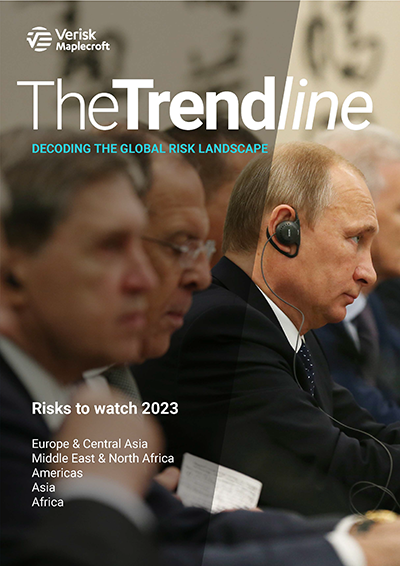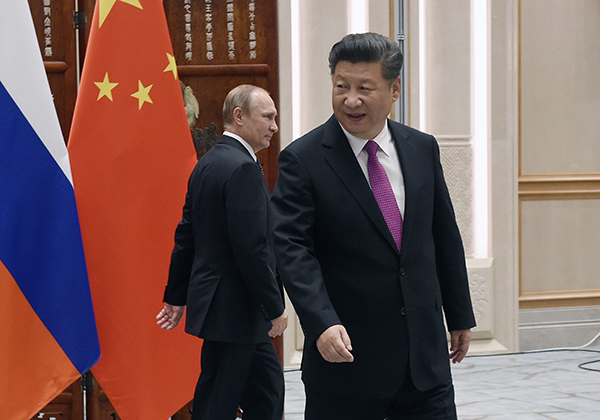The Trendline - Africa: Risks to watch
by Maja Bovcon and Mucahid Durmaz and Ben Hunter and Aleix Montana and Emma Whiteacre,
Africa is in for a busy year and corporates, investors and insurers have plenty to keep an eye on. To help businesses stay ahead of the curve, these are our top 5 trends to watch in 2023: a slew of consequential national elections; resource nationalism on the march in some quarters; the cascading impacts of a looming public debt crunch; Africa on the front line of global food insecurity; and the dilemma over how to finance Africa’s climate transition.
A slew of consequential national elections
Top of the list is the continent’s packed electoral calendar, with 13 sub-Saharan African countries set to organise presidential and legislative elections in 2023. We expect few major shifts in power and the associated policy uncertainty that typically comes with them, but continuity does not herald a radical improvement in the business environment.
In Nigeria, Muhammadu Buhari’s dysfunctional eight-year rule is coming to an end. The ruling APC party’s candidate, Bolu Tinubu, is likely to win narrowly against the main opposition PDP’s Atiku Abubakar and the Labour Party’s populist outsider Peter Obi. A Tinubu presidency would represent a continuation of Buhari’s failed economic policies, including statist interventions, such as a disastrous land border closure in 2019 that spurred inflation. The prospect of a tight result means that a legal challenge is likely, although history suggests the outcome will be upheld. Widespread frustration with rampant insecurity and deep socioeconomic problems, combined with dissatisfaction around the political status quo, means we expect post-electoral protests in urban areas if Tinubu does win.
Elsewhere, DR Congo’s President Felix Tshisekedi and Zimbabwe’s President Emmerson Mnangagwa will likely retain power in competitive – if flawed and potentially delayed – polls; both countries are categorised as high risk on our Democratic Governance Index in 2023-Q1. Divided opposition means Liberia’s President George Weah, Gabon’s President Ali Bongo and Madagascar’s President Andry Rajoelina are also well placed to secure another term in office. More of the same is likely to equate to the same old problems.
Resource nationalism on the march in some quarters
Resource-rich countries will try to capitalise on global demand to bolster energy security and transition towards greener forms of energy in 2023. Strained public finances, caused by the pandemic and the Russia-Ukraine war, will incentivise many governments to try and extract greater benefits from their natural resources. Over the past year, more sub-Saharan African countries have seen their score on our Resource Nationalism Index deteriorate than improve and this trend is likely to continue in 2023 (see chart below).
Foreign operators are likely to be subject to continued state intervention in the natural resource sector in Guinea, Cameroon and Ghana; fewer tax exonerations in Burundi, Congo and Liberia, and; increased efforts to boost local mineral processing in Zimbabwe, Guinea, DR Congo and Zambia.
Yet, direct expropriation of foreign-owned mines and oil fields in 2023 is unlikely. Reforms undertaken by Zambia and Tanzania mean miners will be eyeing future-facing commodity opportunities in both jurisdictions. And countries with vast untapped mineral resources, such as Angola, are also likely to provide investment incentives to attract foreign miners in the year ahead.
The cascading impacts of a looming public debt crunch
Africa entered 2023 with public debt averaging 55%, its highest level in over a decade. After borrowing heavily since the 2008 financial crash, the cumulative impacts of the COVID-19 pandemic and Russia’s invasion of Ukraine mean that eight sub-Saharan African countries are currently unable to pay creditors, and 14 others are at high risk of a similar fate. Mozambique, Zambia and Chad are just three of the most high-profile examples.
In 2023, the likely consequence of this trend will be austerity measures and rises in the cost of debt servicing, which already eat up 19% of Africa’s foreign exchange earnings. Squeezed government budgets will slow economic growth, exacerbate poverty and cause a cascade of other ESG+Political risks across the continent. Healthcare, education, the environment, human rights, and security will all suffer. Mozambique is a case in point. With a gross debt of 102% of GDP, the country’s USD1.51 billion debt servicing costs in 2023 will hinder the Nyusi administration’s ability to counter Islamist insurgents in Cabo Delgado.
Furthermore, 32 African countries saw their score on our Poverty Index decline in 2022 and this trend will be exacerbated by increased sovereign indebtedness in 2023, with rippling effects across different social metrics.
Geopolitics: Africa on the front line of global food insecurity
Food insecurity will remain a major risk in 2023, despite the relative fall in global food and fertiliser prices since their unprecedented spike in the wake of Russia’s invasion of Ukraine. The price and availability of food will remain particularly exposed to the evolution of the Russia-Ukraine war and extreme weather events.
Africa is the region that has experienced the largest deterioration on our Food Security Index in the last two years, and now accounts for 17 of the 21 countries categorised as extreme risk. Agriculture-dependent countries in the Sahel, Central Africa, and the Horn of Africa, already suffering the impact of the longest drought in recent history, are among the most vulnerable to climate-driven food insecurity (see chart below).
A global food crisis would fuel migration, civil unrest and government instability in sub-Saharan Africa, dynamics which can disrupt business operations, undermine investment returns, and cause insurance industry losses.
The Sovereign ESG landscape: Debt and climate finance - dilemma and opportunity
Debt restructuring will remain in the spotlight, as post-pandemic fragility overwhelms public finances in several African nations. The G20 Common Framework for Debt Treatment draws together public and private creditors to streamline debt restructuring, with Chad the first to agree a deal in November 2022. Zambia and Ethiopia are also seeking relief under the framework, but dire sovereign governance profiles and concerns around opaque Chinese loans risk Western bondholder buy-in.
Against this challenging backdrop, the question of how to finance Africa’s climate transition becomes ever more urgent. To achieve Paris Agreement targets, the continent will need around USD250 billion annually to 2030. Current climate finance flows are a tenth of that. Mobilising funds at scale will necessitate de-risking, including through forms of blended finance, whereby concessional donor finance is combined with private capital.
South Africa’s ‘Just Energy Transition’ with international partners will serve as a model for carbon-intensive sovereigns, while debt for nature swaps, as per a WWF proposal for Zambia, could emerge as an important mechanism to help alleviate fiscal pressure across the continent and prevent environmental degradation.





